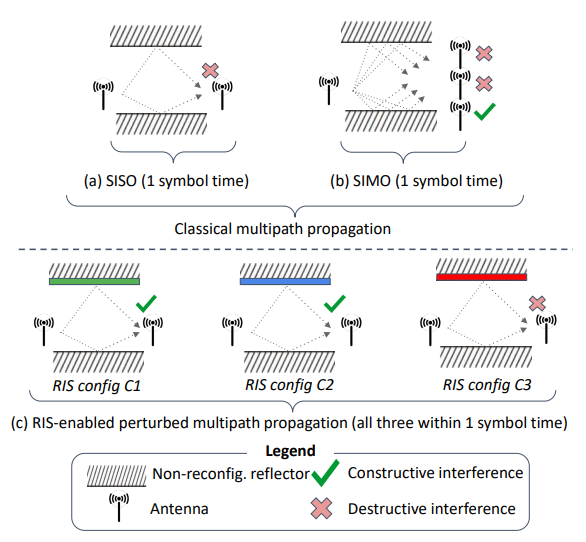RIS-STAR: RIS-based Spatio-Temporal Channel Hardening for Single-Antenna Receivers
Abstract:
Small form-factor single antenna devices, typically deployed within wireless sensor networks, lack many benefits of multi-antenna receivers like leveraging spatial diversity to enhance signal reception reliability. In this paper, we introduce the theory of achieving spatial diversity in such single-antenna systems by using reconfigurable intelligent surfaces (RIS). Our approach, called ‘RIS-STAR’, proposes a method of proactively perturbing the wireless propagation environment multiple times within the symbol time (that is less than the channel coherence time) through reconfiguring an RIS. By leveraging the stationarity of the channel, RIS-STAR ensures that the only source of perturbation is due to the chosen and controllable RIS configuration. We first formulate the problem to find the set of RIS configurations that maximizes channel hardening, which is a measure of link reliability. Our solution is independent of the transceiver’s relative location with respect to the RIS and does not require channel estimation, alleviating two key implementation concerns. We then evaluate the performance of RIS-STAR using a custom-simulator and an experimental testbed composed of PCB-fabricated RIS. Specifically, we demonstrate how a SISO link can be enhanced to perform similar to a SIMO link attaining an 84.6% channel hardening improvement in presence of strong multipath and non-line-of-sight conditions.
Fig. 1: Illustration of how RIS-STAR achieves channel hardening comparable to SIMO with a single-antenna receiver: (a) signal loss caused by destructive interference in a SISO link resulting from multipath, (b) signal recovery using spatial diversity from the multi-antenna receiver in SIMO, and (c) RIS-STAR enables the same diversity gain in SISO via perturbing the channel by changing RIS configurations at an intra-symbol level.

Fig. 2: Custom-built Reconfigurable Intelligent Surface. .
Video Demonstration:
Links to Project Files:
Please use following links to access RIS fabrication design files, testbed schematics with Gnu-Radio code, and configuration-orchestrating software, and RIS-STAR Python simulator:RIS-STAR Simulator
RIS-STAR implementation
These hardwares and programs were used for the paper "RIS-STAR: RIS-based Spatio-Temporal Channel Hardening for Single-Antenna Receivers". Please use this link to download the paper.
Any use of these hardwares and programs which results in an academic publication or other publication which includes a bibliography should include a citation to our paper. Here is the reference for the work:
Conference version:
S. G. Sanchez, K. Alemdar, V. Chaudhary, K. Chowdhury, "RIS-STAR: RIS-based Spatio-Temporal Channel Hardening for Single-Antenna Receivers,” IEEE InfoCom 2023, New York, USA, 2023.

